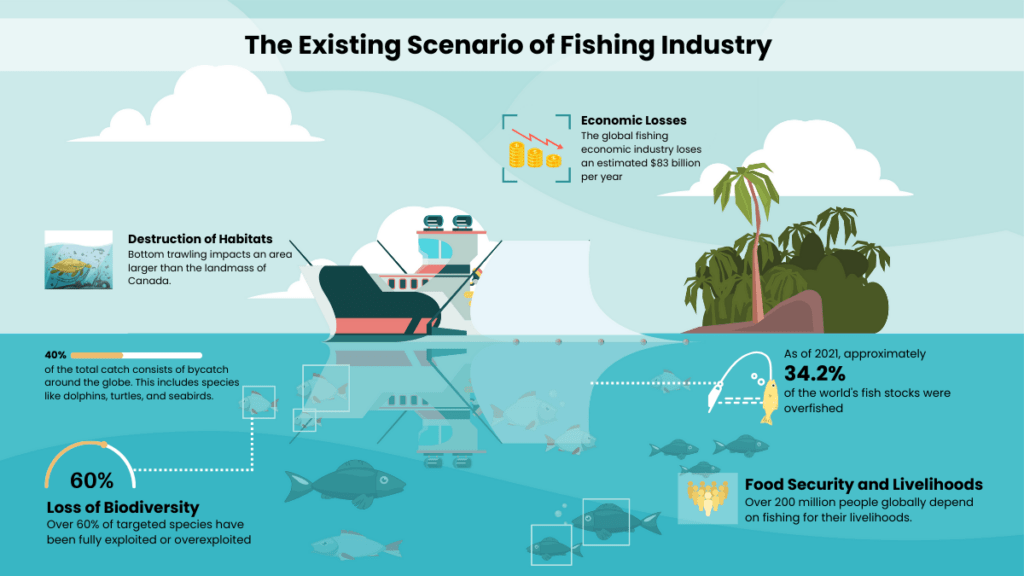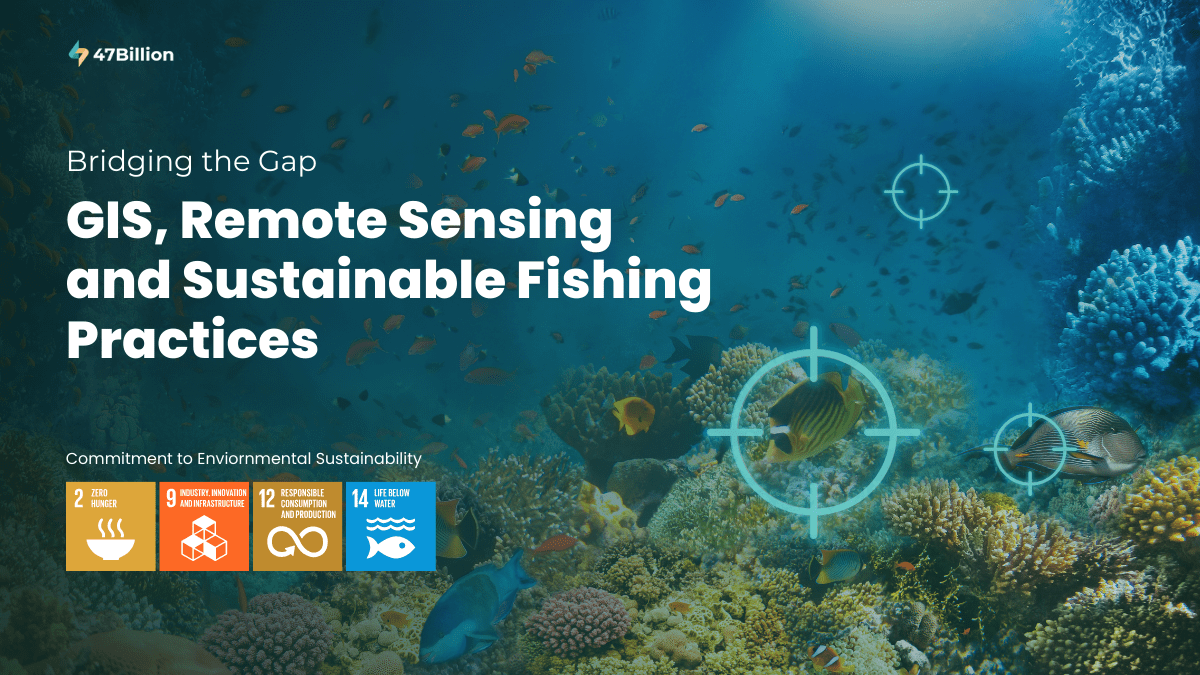The 1982 UN Convention on the Law of the Sea (UNCLOS) reshaped coastal States’ obligations within their exclusive economic zones (EEZs), emphasizing responsible resource use. This entails economic development and robust marine resource management, including fisheries. Commitment to sustainable fish stock exploitation is achieved through advanced fisheries governance, ecosystem-oriented initiatives like marine protected areas (MPAs), and combating illegal, unreported, and unregulated (IUU) fishing. UNCLOS, as an international framework, closely aligns with the blog’s focus on the pivotal role of GIS (Geographical Information System) and remote sensing in fostering transparency, traceability, and sustainability within the seafood industry.
GIS was developed as a terrestrial use tool for infrastructural development, watershed management, and agriculture and forest conservation. Still, later, it became a supporting tool in many diverse sectors. Geographical Information Systems and their technologies have added a new leeway in the fishery sector by applying its tools for extracting scientific output from the collected data. GIS is now being applied in a variety of fields. In marine fisheries till the last decade, GIS and its applications were very limited. Still, the scenario has been completely changed with the development of successful protocols for applications of GIS in marine.
In augmenting global fish production, GIS is contributing immensely. GIS targets a broad spectrum of users, including researchers, planners, and managers. The commercial aquaculture and fishing industries are home to additional beneficiaries. Although GIS is most usually utilized as a tool for decision-making, it is increasingly used for tasks related to administration and regulation. Site allocation concerning administrative jurisdictions and environmental carrying capacity are examples of potential applications. To maximize extension efforts, GIS can also be utilized administratively and operationally to link the locations of specific cultural sites or clusters.
Understanding the existing scenario

Before delving into the technological aspects, comprehending the fishing industry’s challenges is crucial. Overfishing is depleting marine populations, disrupting ecosystems, and threatening the livelihoods of countless people dependent on fishing. Additionally, there is a significant issue with illegal, unreported, and unregulated (IUU) fishing, which contributes to overfishing and poses severe environmental and economic concerns. Lastly, as consumers become more conscious of where their food comes from, there is a growing demand for transparency in the seafood supply chain.
Traceability becomes critical in the fight to ensure that our seafood is safe, legally caught, and accurately labeled. It ensures that information such as how and where fish are caught or farmed—from capture to market—is accessible throughout the global seafood supply chain. The complex interactions between supply chains and stakeholders, however, introduce challenges. They can make it difficult for traceability programs to be used effectively.
This can benefit illegal, unreported, and unregulated (IUU) fishing operators.
How is GIS transforming the scenario?
GIS helps in the following ways –
1. Geospatial Data Collection: GIS involves capturing, analyzing, and visualization of geospatial data. In the context of fish traceability, this means collecting and integrating data from various sources, including satellites, vessel monitoring systems, and fisheries management databases. This data can include information about the location of fishing vessels, oceanographic conditions, and catch details.
2. Real-time Tracking: One of the most significant advantages of GIS technology is real-time tracking. Fishing vessels equipped with GPS and communication systems can transmit their location and catch data in real-time to central databases. This allows authorities and seafood companies to monitor fishing activities as they happen, making it much more challenging for vessels to engage in IUU fishing.
3. Supply Chain Transparency: GIS also enables end-to-end traceability in the seafood supply chain. Every step can be tracked and recorded from when a fish is caught to the point it reaches your plate. This transparency helps ensure that fish are caught legally and sustainably, and it provides consumers with the information they need to make informed choices about their seafood purchases.
4. Fisheries Management: GIS is a powerful tool for fisheries management. By analyzing geospatial data, authorities can make informed decisions about where and when fishing should be allowed to protect vulnerable species and habitats. This data-driven approach helps balance the economic interests of the fishing industry with the need to preserve marine ecosystems.
5. Environmental Impact Assessment: GIS can also assess the environmental impact of fishing activities. By overlaying fishing data with information about marine habitats and species distributions, researchers can identify areas particularly vulnerable to overfishing and habitat destruction.
Exploring another framework that is making the fishing industry sustainable – Remote Sensing



While GIS provides a data management and analysis framework, remote sensing takes us one step closer to the oceans. Remote sensing involves using satellites and other sensors to collect data about the Earth’s surface and atmosphere. In the context of fish traceability and sustainability, remote sensing offers several critical benefits:
1. Vessel Detection: Satellites equipped with synthetic aperture radar (SAR) can detect and monitor vessels at sea, even in remote or poorly monitored areas. This technology is invaluable for identifying and tracking vessels engaged in IUU fishing.
2. Oceanographic Data: Remote sensing can provide crucial information about oceanographic conditions, such as sea surface temperature, chlorophyll concentration, and ocean currents. These data can help predict the movement of fish stocks and the likelihood of fish aggregations, improving fishing efficiency and reducing bycatch.
3. Environmental Monitoring: Remote sensing can also be used to monitor the health of marine ecosystems. For example, it can detect changes in coral reefs, seagrass beds, and other habitats essential for fish breeding and survival.
4. Compliance Monitoring: By comparing vessel positions obtained from remote sensing with their reported positions, authorities can detect discrepancies that may indicate illegal fishing. This can lead to more effective enforcement of fishing regulations.
Moving a step forward – Collaborative functionality of GIS and Remote Sensing
The true power of GIS and remote sensing in fish traceability and sustainability becomes evident when these technologies are combined. The future of fisheries management relies on a symbiotic GIS and remote sensing ecosystem. This integrated approach will empower policymakers to manage fish stocks, establish protected areas, and combat IUU fishing effectively. Here is how they work together:
1. Integrated Data: GIS can integrate data from remote sensing sources, such as satellite imagery, into its analytical framework. This allows for a comprehensive view of fishing activities concerning environmental conditions.
2. Predictive Analytics: By analyzing historical data on fish movements, catch rates, and oceanographic conditions, GIS can help predict where and when fish will likely be abundant. This information is invaluable for fisheries planning and management.
3. Early Warning Systems: GIS can be used to create early warning systems for IUU fishing. By monitoring vessel movements and identifying suspicious behavior, authorities can take proactive measures to prevent illegal activities.
4. Sustainable Fishing Practices: Combining GIS and remote sensing promotes sustainable fishing practices. It helps fisheries optimize their operations to reduce bycatch, minimize fuel consumption, and improve their efficiency and sustainability.
Challenges and Future Directions
While GIS and remote sensing offer immense potential, they also possess fundamental challenges:
1. Data Integration: Integrating data from various sources can be complex and require standardization to ensure compatibility.
2. Cost: The initial investment in technology and data acquisition can be high, especially for developing countries.
3. Privacy and Security: Sharing vessel data in real time raises privacy and security concerns that must be addressed.
4. Education and Training: Fisheries personnel and managers may require training to use these technologies effectively.
As we look to the future, GIS and remote sensing will continue to play a crucial role in promoting fish traceability and sustainability. Advances in technology, including the miniaturization of sensors and the increasing availability of satellite data, will make these tools more accessible and affordable. Moreover, international collaboration and partnerships will be essential to ensure these technologies benefit fisheries worldwide.
Nurturing a Responsible and Transparent Fishing Industry
In an era when the health of our oceans and the sustainability of our seafood are paramount, GIS and remote sensing have emerged as technological heroes. They promise a more transparent, accountable, and ecologically conscious seafood industry. Through real-time tracking, predictive analytics, and early warning systems, these technologies empower us to protect our marine resources, combat illegal fishing, and make informed choices as consumers. As we navigate the future of fish traceability and sustainability, GIS and remote sensing serve as our guiding lights, illuminating a path toward a healthier, more responsible relationship with the oceans that sustain us.
Related Blog-
Navigating The Seas Of Sustainability: How Seafood Traceability Is Reshaping The Fishing Industry




